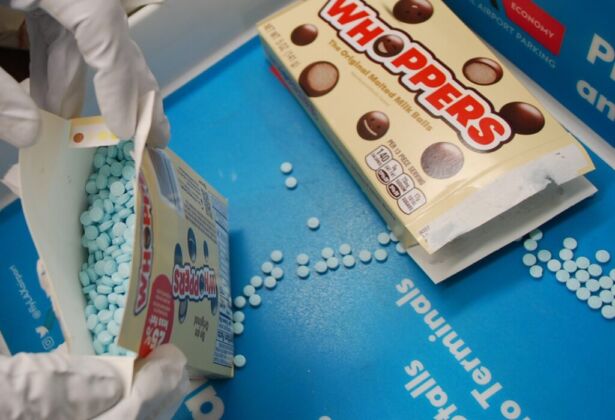Poignant testimony delivered during a Feb. 28 Congressional hearing on the U.S. border crisis brought legislators to a firm conclusion: failed or ineffective immigration policies are directly fueling America’s drug crisis.
“Our country faces record fatalities from drug overdoses, eclipsing 100,000 deaths, 71,000 from synthetic opioids alone,” Rep. Mark Green (R-Tenn.) said during the hearing.
At the forefront of this crisis is fentanyl, a synthetic opioid up to 100 times more potent than morphine. Most of the substance is making its way into the United States from Mexico, much of which is smuggled in by drug cartels.
Though fentanyl seizures at official ports of entry on the U.S. border are on the rise, Sheriff Mark Lamb of Pinal County, Arizona, told the committee that border apprehensions of fentanyl account for only half of what makes it into the United States.

“I hear that 90 percent comes through the ports. Those numbers are not what we’re seeing. It’s 50-50,” Lamb said.
He noted that, despite Pinal not being a border county, the amount of fentanyl his officers have seized has skyrocketed since 2019. Part of that is due to the proximity to Interstate 10, a main artery for drug and human trafficking heading north from Mexico.
Lamb said his jurisdiction had seen a “600 percent increase” in fentanyl pass through his county over the past four years. In 2019, Lamb’s officers seized around 700 pills. That number spiked to more than 200,000 in 2020.
In 2021, Lamb’s task force intercepted more than 1.2 million pills. That number surged yet again in 2022, totaling more than 1.4 million fentanyl pill apprehensions.
He further noted that finding abandoned camouflage gear, backpacks, and “carpet shoes” littering the desert in his county is an everyday occurrence. It suggests a significant number of drug traffickers are making it past border security undetected.
“This is what we deal with on a daily basis,” Lamb said.
Green said the Mexican cartels are calculated in their approach to getting drugs like fentanyl into the United States. He said the traffickers also force illegal immigrants who owe the cartels money for transport into indentured servitude as drug runners.
Green added that despite the increase of fentanyl seized at official ports of entry, the drug is still pouring into the United States. The legislator held up a photo showing 232 pounds of fentanyl seized inland, which bypassed security at the ports of entry.
In an emotional testimony, Michigan resident Rebecca Kiessling shared the story of how Mexican fentanyl killed her two sons in July 2020.
Before the horrific incident, she said, “I didn’t know what fentanyl was … I didn’t know that my boys were taking anything that could kill them. They didn’t think they were either.”
Kiessling said that her two sons, ages 20 and 18, were with a 17-year-old girl and a drug dealer that supplied the trio with fentanyl on July 29. All three youths died shortly after taking the drug.
“Law enforcement made it clear to me that this fentanyl came from Mexico. It came from our southern border,” she said.
Kiessling went on to describe what her former law partner’s husband, a local sheriff, told her. “He has a stack, every day, there’s a stack of dead people [from drug overdoses], and there are no leads.”
However, Kiessling’s case was unique. The dealer who gave her sons the lethal dose of fentanyl was apprehended. Yet he only received a maximum sentence of 15 years for his involvement in the deaths of three youths.
“I found out from the funeral home that they have tons of these cases regularly,” she said, then added for perspective, “I’m from Rochester Hills, Michigan. We were ranked in Money magazine in the top 10 cities to live in America a few years ago.”
The year Kiessling’s son Caleb—one of the overdose victims—was born, in 2000, the number of U.S. drug overdose deaths was roughly 20,000. But the year the young man died, in 2020, that number soared to more than 100,000.
“You talk about children being taken away from their parents. My children were taken away from me … this is a war. Act like it. Do something,” she said.
From The Epoch Times
